
Historic Deerfield is a museum dedicated to the heritage and preservation of Deerfield, Massachusetts, and history of the Connecticut River Valley. Its historic houses, museums, and programs provide visitors with an understanding of New England's historic villages and countryside. It is located in the village of Old Deerfield which has been designated a National Historic Landmark District, and is listed on the National Register of Historic Places. The museum also hosts the Dublin Seminar for New England Folklife.

Saugus Iron Works National Historic Site is a National Historic Site about 10 miles northeast of Downtown Boston in Saugus, Massachusetts. It is the site of the first integrated ironworks in North America, founded by John Winthrop the Younger and in operation between 1646 and approximately 1670. It includes the reconstructed blast furnace, forge, rolling mill, shear, slitter and a quarter-ton trip hammer.

The Rising Paper Mill is a historic factory at 295 Park Street North, in the Housatonic village of Great Barrington, Massachusetts. Built in 1873 for H.D. Cone, it is one of the best-preserved examples of period mill architecture in Berkshire County. The complex was listed on the National Register of Historic Places in 1975. In 2008, the facility was purchased by Hazen Paper, which announced plans to manufacture multi-ply laminated paper for packaging.

The Upper Worthington Historic District of Springfield, Massachusetts encompasses a collection of visually cohesive residential apartment blocks that represent one of the largest residential developments in the city dating to the first three decades of the 20th century. It is centered on a portion of Worthington Street, a major east-west road in the city, between Armory Street and Summit Street, and includes 33 buildings on those three streets as well as Federal and Taylor Streets, near their junctions with either Worthington or Federal. Most of the contributing buildings are four story brick buildings with Georgian detailing and stone trim. The district was first listed on the National Register of Historic Places in 1983, including 28 buildings; the district was expanded in 1992 to add the five buildings on Taylor Street.

Annisquam Harbor Light Station is a historic lighthouse on Wigwam Point in the Annisquam neighborhood of Gloucester, Massachusetts. It can be viewed from nearby Wingaersheek Beach, Gloucester. It lies on the Annisquam River and is one of the four oldest lighthouses to surround the Gloucester peninsula as well as; Eastern Point Light, Ten Pound Island Light, and Thacher Island Light.

The Brown House is a historic First Period house in Hamilton, Massachusetts. Built in the 1660s or 1670s, it is one of the oldest surviving houses in Essex County. It was listed on the National Register of Historic Places in 1990.

The Samuel Chase House is a historic First Period house in West Newbury, Massachusetts. Built c. 1715, it is a rare example of a brick house built during the transition between First Period and Georgian styling and construction methods. A story passed down through the Chase family says that bricks for the house were made on the family's farm and were carried to the homesite by Hannah Chase in her apron. The brick is laid in English bond, and the building is seven bays wide and two stories high. The outermost window bays have been bricked over, leaving the front facade with five windows on the second floor, and two on either side of a central front door in the first floor. The first floor windows and doorway are in arched spaces in the brickwork, while those on the second floor are rectangular. The house underwent a major restoration in 1986.
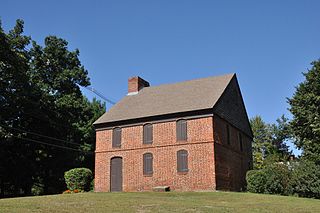
The Dustin-Duston Garrison House or Dustin House is a historic First Period house in Haverhill, Massachusetts. Built about 1700, it is one of a very small number of surviving period houses built out of brick in Massachusetts. It is also notable for its association with the Dustin or Duston family; Hannah Duston was famously captured by Native Americans during a 1697 attack on Haverhill, probably while this house was under construction. The house was added to the National Register of Historic Places in 1990.

The Hazen-Kimball-Aldrich House is a historic First Period house in Georgetown, Massachusetts.

The William Murray House is a historic First Period house on the east side of Salem, Massachusetts. It is a two-story wood-frame house that consists of two distinct sections that have not always been treated as a single unit. Its construction history provides a window into 17th and 18th century building methods. The westernmost section was built c. 1688, and is three window bays wide and a single room in depth. The eastern section, also three bays wide and one room deep, was added in the late 17th or early 18th century. The western portion originally had an overhanging section of the second floor; this was altered in the early 18th century, when the roof was raised to a flatter pitch and the overhanging section was concealed by construction of a flush wall.
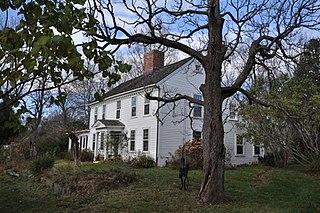
The Smith House, also known locally as the Tilton-Smith House, is a historic house in Ipswich, Massachusetts. Built in the first quarter of the 18th century, it is a good example of late First Period architecture. It suffered serious fire damage in 1998, but underwent a meticulous restoration. It was listed on the National Register of Historic Places in 1990.

The Pearl Street School is a historic school building at 75 Pearl Street in Reading, Massachusetts. Built in 1939, the two-story brick and limestone building is Reading's only structure built as part of a Public Works Administration project. The site on which it was built was acquired by the town sometime before 1848, and served as its poor farm. With fifteen classrooms, the school replaced three smaller wood-frame schoolhouses in the town's school system, and was its first fire-resistant structure.
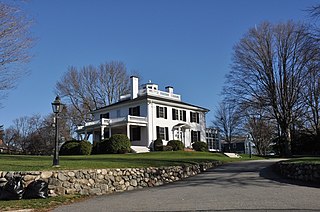
Beebe Homestead, also known as the Lucius Beebe House and Beebe Farm, is a historic Federal period home at 142 Main Street in Wakefield, Massachusetts, which was built during the federal era that extended from the late 18th-century into the 1820s. It is suspected to have been remodeled into the federal style from an earlier home built in circa 1727. It overlooks Lake Quannapowitt, and according to a 1989 study of historic sites in Wakefield, the house is "one of Wakefield's most imposing landmarks." The property was added to the National Register of Historic Places in 1989.

The Jose V. Toledo Federal Building and United States Courthouse is a historic post office and courthouse located at Old San Juan, Puerto Rico. It is a courthouse for the United States District Court for the District of Puerto Rico. It is also the site for oral argument before the United States Court of Appeals for the First Circuit, when that court sits in Puerto Rico.

The Taylor Memorial Library, also known as Taylor Library or Old Library, is a historic former library building at 5 Broad Street in Milford, Connecticut. Built in 1894, it is a Richardsonian Romanesque building designed by Joseph W. Northrop. It follows, but departs from, H. H. Richardson's design of the Crane Memorial Library in Massachusetts. The building was listed on the National Register of Historic Places in 1979. It now houses the offices of the Milford Chamber of Commerce.
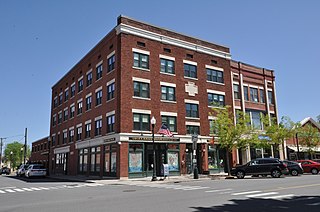
Benson's New Block and the Mohawk Chambers are a pair of mixed commercial and residential buildings at Main and Wells Streets in downtown Greenfield, Massachusetts. Built in 1913 and 1916, they are well-preserved and little-altered examples of period Neo-Classical commercial architecture. The buildings were listed on the National Register of Historic Places in 2014.

The Portsmouth Academy building is a historic academic and civic building at 8 Islington Street in Portsmouth, New Hampshire. Built in 1809, it is one of the finest surviving examples of an early 19th-century academic building in northern New England, and is attributed to James Nutter, one of the finest local builders of the period. In addition to housing the Portsmouth Academy, it later housed the city's public library, and presently houses the Portsmouth Historical Society galleries, gift shop and the Discover Portsmouth Welcome Center. It was listed on the National Register of Historic Places in 1973 as "Portsmouth Public Library".

The Queensbury Mill is a historic mill building at 1 Market Street in Somersworth, New Hampshire. Built in 1884, it is unusual for the period for its wood-frame construction, and for its financing, executed by local businessmen to attract shoe manufacturers to the city. The mill was listed on the National Register of Historic Places in 1987. The building has been converted into apartments.
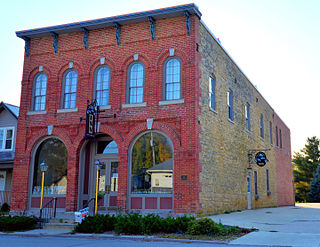
The Wenzil Taylor Building is a historic building located in Spillville, Iowa, United States. Wenzil Taylor had this building constructed in 1871 for use as a general merchandise store. It is located in the town's original commercial district, and it is the last remaining commercial structure from that era.






















